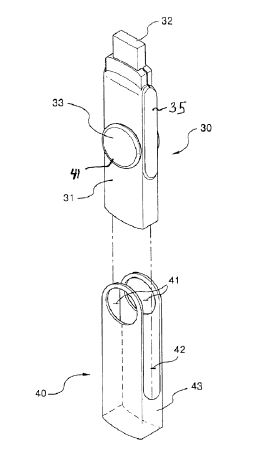The Federal Circuit’s recent decision in Pavo Solutions LLC v. Kingston Technology Company, Inc. sheds light on situations where it is appropriate for a court to rewrite claim language to preserve the drafter’s intent. The case also limits the extent to which defendants can avoid willful infringement by relying on clerical errors in claim language.
Pavo is the owner of U.S. Patent No. 6,926,544, which relates to a flash memory device with a rotating cover that pivots so that the cover does not need to be completely removed during use. An example of such a device, as illustrated in the ‘544 patent, is shown below, including the flash memory case (30) for the main body and rotating cover (40):

Claim 1 of the ‘544 patent recites in part “pivoting the case with respect to the flash memory main body,” despite the fact that the “case” is described earlier in the claim and in the specification as a part of the main body. The district court accordingly held that recitation of “case” in the foregoing phrase was a clerical error, and interpreted claim 1 to require pivoting the cover with respect to the main body. Kingston Technology was subsequently found liable for $7.5 million in damages for infringement, which was enhanced by 50 percent for willful infringement.
On appeal, the Federal Circuit agreed with the district court that the recitation of “case” instead of “cover” in the claim phrase relating to pivoting was an obvious minor clerical error that was appropriately subjected to judicial correction. The court pointed out that the limitations of the claim itself show that the reference to the case was an error because the cover is described as the portion that necessarily pivots with respect to the main body. Additionally, the claim did not make sense on its face, because the case is part of the main body, and therefore cannot pivot with respect to a component of which it forms a part. Finally, the specification confirms the error by exclusively identifying the cover as the pivoting portion of the device.
In its decision, the court distinguished its 2004 holding in Chef America, Inc. v. Lamb-Weston, Inc., where it refused to re-write “heating…dough to a temperature…of about 400° F to about 850° F” to instead mean “…at a temperature…of about 400° F to about 850° F” (emphasis added) even though it was undisputed that heating the dough itself (rather than an oven in which the dough is baked) to the specified temperature would burn the dough to a crisp. Unlike in Chef America, the earlier limitations of the claim in Pavo showed that there was an error by describing the “cover,” not the “case,” as the pivoting portion. Further, the claim as written did not make sense because the case cannot pivot with respect to a component of which it is a part, whereas the claim in Chef America included a limitation that merely led to an undesirable, but not impossible, result. In addition, in Chef America the patent specification and prosecution history presented no evidence that use of the term “at” was an error, and, significantly, the patentee made no attempt to have the error corrected by action of the district court.
In Pavo, the court also refused to set aside the willful infringement verdict against Kingston. Kingston argued that it did not infringe the claims as originally written and could not have anticipated that a court would later correct the claims. The Federal Circuit held, however, that reliance on an obvious minor clerical error in the claim language is not a defense to willful infringement, because the obvious error cannot mask the meaning of the claim.
This case is significant in that a verdict of willful infringement was upheld even though it was technically impossible to infringe the claims as issued. Accused infringers and their counsel therefore should be wary of reliance on overly-technical aspects of claims, especially apparent typographical errors where intrinsic evidence within the patent or its prosecution history provides evidence that the patentee intended the claims to have a particular scope.